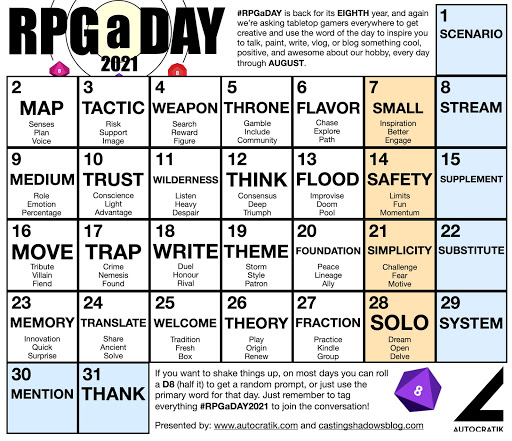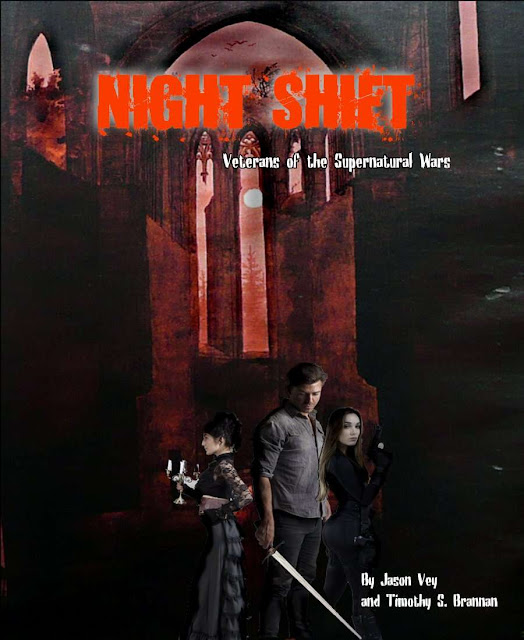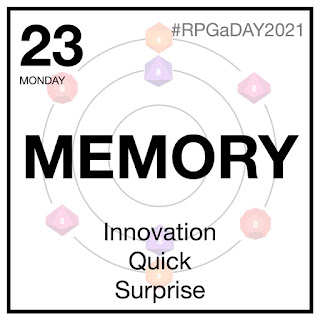
On the tail of the Old School Renaissance has come another movement—the rise of the fanzine. Although the fanzine—a nonprofessional and nonofficial publication produced by fans of a particular cultural phenomenon, got its start in Science Fiction fandom, in the gaming hobby it first started with
Chess and
Diplomacy fanzines before finding fertile ground in the roleplaying hobby in the 1970s. Here these amateurish publications allowed the hobby a public space for two things. First, they were somewhere that the hobby could voice opinions and ideas that lay outside those of a game’s publisher. Second, in the Golden Age of roleplaying when the Dungeon Masters were expected to create their own settings and adventures, they also provided a rough and ready source of support for the game of your choice. Many also served as vehicles for the fanzine editor’s house campaign and thus they showed another DM and group played said game. This would often change over time if a fanzine accepted submissions. Initially, fanzines were primarily dedicated to the big three RPGs of the 1970s—
Dungeons & Dragons,
RuneQuest, and
Traveller—but fanzines have appeared dedicated to other RPGs since, some of which helped keep a game popular in the face of no official support.Since 2008 with the publication of
Fight On #1, the Old School Renaissance has had its own fanzines. The advantage of the Old School Renaissance is that the various Retroclones draw from the same source and thus one
Dungeons & Dragons-style RPG is compatible with another. This means that the contents of one fanzine will compatible with the Retroclone that you already run and play even if not specifically written for it.
Labyrinth Lord and
Lamentations of the Flame Princess Weird Fantasy Roleplay have proved to be popular choices to base fanzines around, as has
Swords & Wizardry. Another choice is the
Dungeon Crawl Classics Role Playing Game.
Published by
Straycouches Press,
Crawl! is one such fanzine dedicated to the
Dungeon Crawl Classics Role Playing Game. Since
Crawl! No. 1 was published in March, 2012 has not only provided ongoing support for the roleplaying game, but also been kept in print by Goodman Games. Now because of online printing sources like Lulu.com, it is no longer as difficult to keep fanzines from going out of print, so it is not that much of a surprise that issues of
Crawl! remain in print. It is though, pleasing to see a publisher like Goodman Games support fan efforts like this fanzine by keeping them in print and selling them directly.
Where
Crawl! No. 1 was something of a mixed bag,
Crawl! #2 was a surprisingly focused, exploring the role of loot in the
Dungeon Crawl Classics Role Playing Game and describing various pieces of treasure and items of equipment that the Player Characters might find and use. Similarly,
Crawl! #3 was just as focused, but the subject of its focus was magic rather than treasure. Unfortunately, the fact that a later printing of
Crawl! No. 1 reprinted content from
Crawl! #3 somewhat undermined the content and usefulness of
Crawl! #3. Fortunately,
Crawl! Issue Number Four was devoted to Yves Larochelle’s ‘The Tainted Forest Thorum’, a scenario for the
Dungeon Crawl Classics Role Playing Game for characters of Fifth Level.
Crawl! Issue V continued the run of themed issues, focusing on monsters, but ultimately to not always impressive effect, whilst
Crawl! No. 6: Classic Class Collection presented some interesting versions of classic
Dungeons & Dragons-style Classes for
Dungeon Crawl Classics, though not enough of them.
Crawl! Issue No. 7: Tips! Tricks! Traps! was a bit of bit of a medley issue, addressing a number of different aspects of dungeoneering and fantasy roleplaying, whilst
Crawl! No. 8: Firearms! did a fine job of giving rules for guns and exploring how to use in the
Dungeon Crawl Classics Role Playing Game and
Crawl! No. 9: The Arwich Grinder provided a complete classic Character Funnel in Lovecraftian mode.
Published in August, 2014,
Crawl! Number 10: New Class Options returns to the theme of the earlier
Crawl! No. 6: Classic Class Collection, that of Class in the
Dungeon Crawl Classics Role Playing Game. One of the design cues for
Dungeon Crawl Classics Role Playing Game is
Basic Dungeons & Dragons in that it employs the ‘Race as Class’ option for its choice of character Classes, that the Dwarf, the Elf, and the Halfling are all Classes in their own right. This as opposed to
Advanced Dungeons & Dragons and later iterations of the world’s most popular roleplaying game which separated the two and allowed a player to combine the Race and Class of his choice. Such options are not present in the
Dungeon Crawl Classics Role Playing Game though, and further, the
Dungeon Crawl Classics Role Playing Game is not a game which has presented such options. So there is no equivalent of the
Player’s Handbook 2 or the
Dungeon Master’s Guide 2 for the
Dungeon Crawl Classics Role Playing Game. The space left by such an omission—if omission it is—is exactly that into which fanzines and similar publications like
Crawl! and in this case,
Crawl! Number 10: New Class Options, can step.
In particular,
Crawl! Number 10: New Class Options focuses on the Demi-Human Classes—the Dwarf, the Elf, and the Halfling. It provides new options to play each of these Races, but through a new Class. For the Dwarf, this is the Dwarven Priest by Jeffrey Tadlock. Primarily Lawful—though Chaotic and Neutral ones exist—this Class combines the abilities of the Dwarf, the Cleric, and the Warrior. The Class gains a deed die from Third Level and can perform a Mighty Deed of Arms, but also gains several spells known per Level. The other three new Classes are by Rev. Dak J. Ultimak. These start with the Elven Rogue which combines the magic of the Elf Class with the thiefing skills of the Thief, which are necessarily beholden to a Patron as the Elf normally is. Just like the Thief, the skill bonuses the Elven Rogue is determined by his Alignment—Lawful, Chaotic, or Neutral. The Halfling Burglar is given a similar set of tables as it moves the traditional Halfling of the Dungeon Crawl Classics Role Playing Game away from his martial bent and towards what is seen as the traditional role for the Halfling—or at least its traditional role for its inspiration. So the Halfling Burglar is thus more like the supposed role of Bilbo Baggins from
The Hobbit. Guidance is included in the descriptions of the Elven Rogue and the Halfling Burglar with the ‘My Thief, My Way’ from
Crawl! No. 6: Classic Class Collection should a player want to modify which skills he wants his Rogue—Elf or Halfling—to have. The last Class in the fanzine is another Halfling Class which where the Halfling Burglar makes the Halfling be a Thief, makes the Halfling a Warrior! The Halfling Champion combines the Mighty Deed of Arms of the Warrior with Luck of the Halfling and adds to it the ability to wield the longsword, the Warhammer, and the heavy axe not in the one hand as per other Races because Halflings are tiny, but two-handed! This comes at a penalty to the Halfling Champion’s Initiative die, but nevertheless, the Halfling Champion is a doughty, fearless warrior ready to step forward* and protect his village.
* I would have written ‘ready to step up’, but that is Halflingist.
These four Classes are engaging and fun, offering new roleplaying opportunities. For example, playing a Halfling Champion would be wholly different to playing a Halfling. However, it would have been nice to have been given some information on who or what the Dwarven Priest typically worships, so the inclusion of a Patron or two would have been a nice inclusion. As well as offering new choices, the inclusion of the four Classes do something else, and that is push
Dungeon Crawl Classics Role Playing Game further away from the baseline of
Basic Dungeons & Dragons and more towards
Advanced Dungeons & Dragons—though still a long way from getting there. Just as with any content in a fanzine, these four Classes are all optional, but their inclusion would be worth considering.
Just as there is no combining Race and Class in
Dungeon Crawl Classics Role Playing Game, there is no Multi-Classing either. ‘Half-Levels’ is Daniel J. Bishop’s solution to this, enabling a player to select a half-Level up to three times, each time choosing the equivalent of Zero Level in another Class. Then at subsequent Levels switch to the new Class. The mechanics feel just a little too complex to easily provide what the author is trying to do, but they include notes for all of the core Classes in the roleplaying game as well as those which appeared in the earlier
Crawl! No. 6: Classic Class Collection, so ultimately the article covers a lot of choices whilst providing the player with even more options.
Colin Chapman’s ‘Not Just a Pretty Face’ provides a means for a player to create the random physical appearance for his character. It starts with a baseline for each Race and adds a Baseline followed by hair and eye colour, and so on. Lastly, the player can roll for a physical feature, whether negative, neutral, or positive. All very neat and simple, enabling the player to add colour and detail to his character’s appearance, and the Judge to do the same for her NPCs. Lastly, Noah Stevens casts a spotlight on three different third-party Races in ‘Three Weird Races’. Each is accompanied by a link, whether a blog or DrivethruRPG.com. Potentially useful at the time of the issue’s publication, but ultimately more filler than useful.
Physically,
Crawl! Number 10: New Class Options is decently done, a clean and tidy affair. The artwork—done by Mario T—is a lot of fun and really captures the feel of the four new Classes in particular.
Crawl! Number 10: New Class Options is very serviceable issue. The high points of the issue are the four new Classes, which expand the play of
Dungeon Crawl Classics Role Playing Game with new options and new roleplaying potential. Whether or not the Judge or her players want to expand their game and thus move away from the core of the
Dungeon Crawl Classics Role Playing Game is their choice, but the options are there.






















